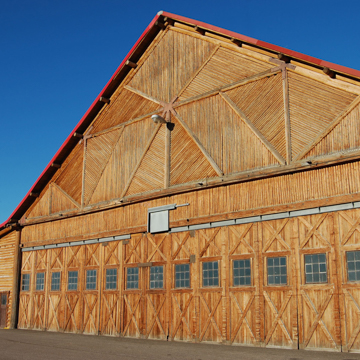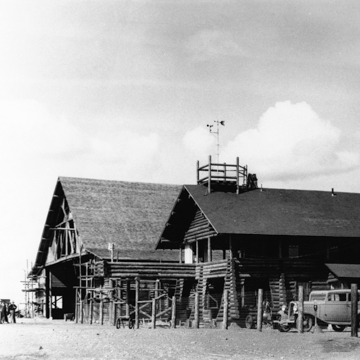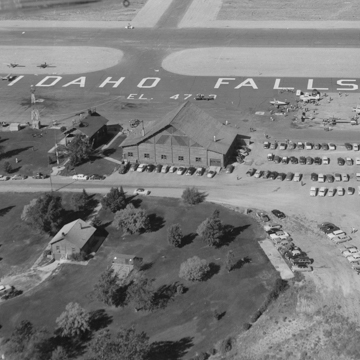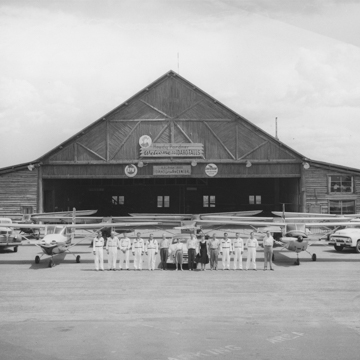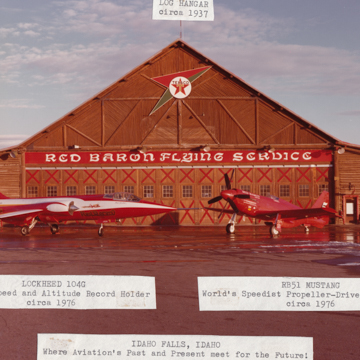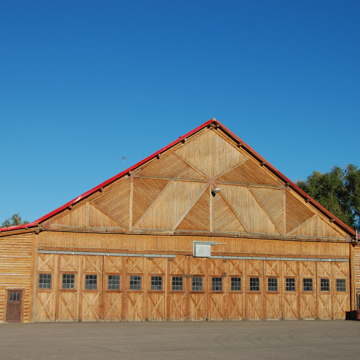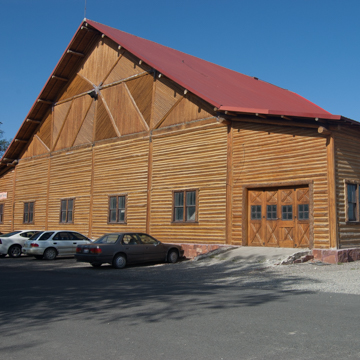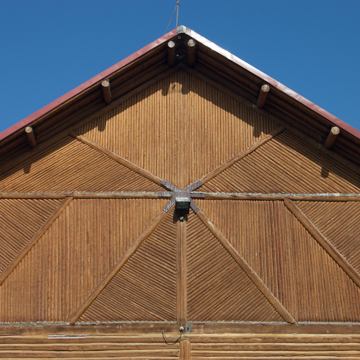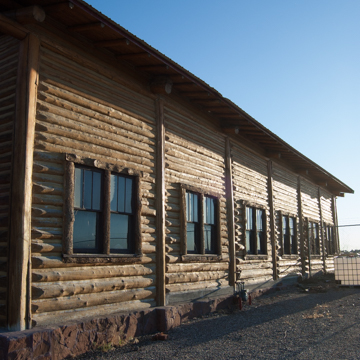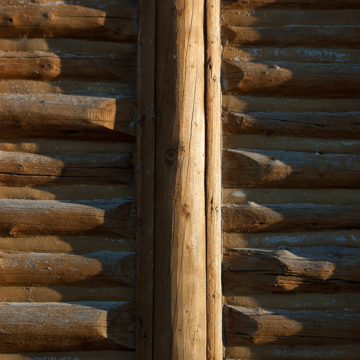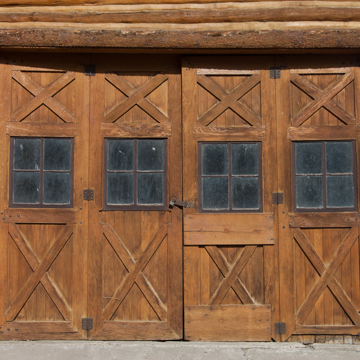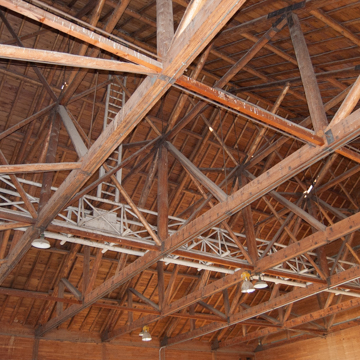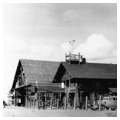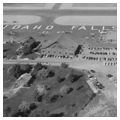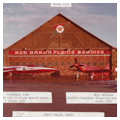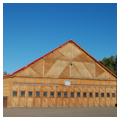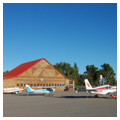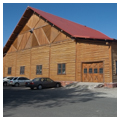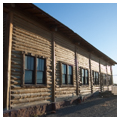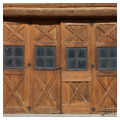You are here
Red Baron Hangar
The Red Baron Hangar, built by the Works Progress Administration (WPA) in 1936, is one of the last all-log hangars remaining in the country. The hangar was the largest component of the initial Idaho Falls Municipal Airport, which also included a landing strip, beacon tower, terminal, and administrator’s cabin. Importantly, this early airport ushered commercial aviation into the Idaho Falls area. It continued to service planes, pilots, passengers, and airmail until a new air terminal opened in 1960. Since then it has housed general aviation services and, notably, two of the world’s fastest airplanes.
Aviation in Idaho Falls began in 1911 when Charles Willard flew his Curtis biplane from the fairgrounds and wowed spectators. During the following decade, barnstormers performed from the fairgrounds or nearby pastures as part of their circuits around the country. After World War I, signaling a maturation of the flying industry after the pioneering era of barnstormers, Fixed Base Operations (FBOs) developed, providing permanent housing for aircraft along with fuel, maintenance, and repair facilities. The Red Baron became one of these.
In 1929, under leadership of Mayor Barzilla Clark, Postmaster Joe Marley, and aviation enthusiast Bill Hackbarth, Idaho Falls acquired 200 acres of land upon which to construct an airport. On this a north-south landing strip, 4,000 by 500 feet, was leveled along with an east-west strip of 3,800 by 500 feet. City engineer Claude Black supervised construction performed by horse-drawn equipment. The city completed the first landing strip and an angle iron beacon tower in 1930 and D.F. Richards built the first aircraft hangar in 1931.
The WPA began to support airport construction in 1935 and prioritized airport projects both for national defense and civilian passengers and mail. WPA’s policies required sponsors to provide land, plans, specifications, and technical supervision of construction along with a commitment to operate and maintain aviation facilities for the public. Following these policies, in 1935 WPA and Idaho Falls partnered to provide plans and funding for a new airport. Under this partnership, three log buildings—the hangar, terminal, and an administrator’s cabin—were completed by 1936 and runways extended and improved and fueling tanks and pumps installed by 1937. Federal oversight certified that facilities met national standards and an operational permit was issued in 1938.
The Red Baron Hangar is a tripartite rectangular structure whose larger, gable-roofed central section is bookended by shed-roofed wings on the north and south. The central space accommodates aircraft storage and the north wing is used for maintenance and repair. The two-story south wing originally served as a locker room and flight school classroom, but it now houses offices. The hangar is crafted of hand-hewn, peeled, native white pine logs. Side walls were built using “piece-sur-piece” construction (in which ends of stacked horizontal logs are tapered so as to fit into grooved vertical posts). The logs, chinked with a soft mortar, sit on a concrete foundation faced with red sandstone. Hangar doors, in two 40-foot sections, are articulated into eight 5-foot wood plank panels hanging from a metal rail. In the center of each panel is a 9-light window with a cross-buck decoration above and below. Other doors and windows are framed with unpeeled half-logs. Exposed trusses defining the gable ends are identical to those within, but here the spaces between chords and webs are filled with small diameter peeled logs. Although the original roof was wood, it was covered with metal in the 1960s.
When first built, the Idaho Falls Airport was a stop between Salt Lake City and Helena, Montana, and a stop en route to Yellowstone National Park. The airport was operated by various people over the years including E.G. McCarty from 1950 to 1952, followed by H.P. Hill, who purchased the business and opened Idaho Aviation Center in 1953. Idaho Aviation Center provided Cessna Aircraft sales and service, aircraft repair, spraying and dusting, flight school, air taxi, air ambulance, and aircraft parts and supplies from 1953 to 1956. In 1956 the Idaho Falls Municipal Airport was renamed Fanning Field and from 1957 to 1958 a new terminal building was built.
When the new terminal opened in 1960, the older log terminal was demolished and the historic hangar took on a niche role for general aviators as an FBO. In 1973 J.E. Browning purchased the FBO and used it for the Red Baron Flying Service, named after World War I German flying ace, Manfred von Richthofen. The following year Browning formed the Red Baron Air Racing Team. The team purchased a P-51D Mustang, hired Lockheed engineers to modify it, and raced it. In 1979, Steve Hinton piloted the plane to set the low-level propeller-driven air speed record of more than 499 miles per hour, a record held for a decade. In 1976, the Red Baron Air Racing Team purchased, modified, and exhibited nationally a Lockheed F-104 Starfighter jet race plane. Darryl Greenamyer, Lockheed test pilot, rebuilt the plane with parts assembled from throughout the nation. The next year he piloted the plane to set the low-level speed record of more than 988 miles per hour, a record that still stands.
In 1984, John and Bob Hoff founded Aero Mark, an FBO that provides fuel, aircraft sales, storage, maintenance, avionics (radio), catering, charger, rental, and flight training. Aero Mark continues to serve general aviation needs, but in addition to the Red Baron Hangar, Aero Mark has expanded services and facilities to include a 30,000-square-foot, state-of-the-art hangar in which the Hoff family continues to provide premium aviation services. Aero Mark also sponsors events such as the Idaho Aviation Expo. The Red Baron Hangar, listed on the National Register of Historic Places since 1997, along with its contemporaneous administrator’s cabin and 1930 beacon, continues to serve the Idaho Falls aviation community with helicopter flight training and aircraft storage.
References
Aero Mark: Keep Idaho Falls Flying for 22 Years. Idaho Falls, ID: Idaho Falls Chamber of Commerce. 2006.
“H. P. ‘Pete’ Hill.” Obituary. The Post Register(Idaho Falls), May 11, 1999.
Hill, H. P. Aviation Development within the Idaho Falls Area. Idaho Falls, ID: The Idaho Falls Centennial Plus Twenty Committee. May 1985.
Marker, Joe L. “Aero Mark Caters to Pilots.” The Post Register(Idaho Falls), October 7, 1984.
“Report on Progress of the WPA Program.” Federal Works Agency, Work Projects Administration, June 30, 1940.
Shaw, William R., “Idaho Falls Airport Historic District,” Bonneville County, Idaho. National Register of Historic Places Registration Form, 1997. National Park Service, U.S. Department of the Interior, Washington, D.C.
Writing Credits
If SAH Archipedia has been useful to you, please consider supporting it.
SAH Archipedia tells the story of the United States through its buildings, landscapes, and cities. This freely available resource empowers the public with authoritative knowledge that deepens their understanding and appreciation of the built environment. But the Society of Architectural Historians, which created SAH Archipedia with University of Virginia Press, needs your support to maintain the high-caliber research, writing, photography, cartography, editing, design, and programming that make SAH Archipedia a trusted online resource available to all who value the history of place, heritage tourism, and learning.




















